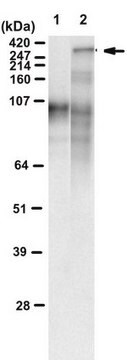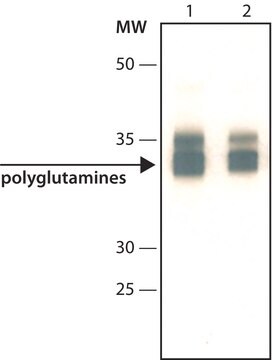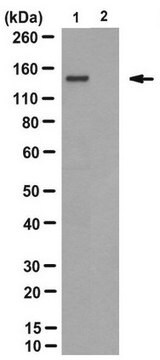MAB5374
Anti-Huntingtin Protein Antibody, clone mEM48
culture supernatant, clone mEM48, Chemicon®
Synonym(s):
Huntingtin
About This Item
Recommended Products
biological source
mouse
Quality Level
antibody form
culture supernatant
antibody product type
primary antibodies
clone
mEM48, monoclonal
species reactivity
human
species reactivity (predicted by homology)
mouse, rat
manufacturer/tradename
Chemicon®
technique(s)
immunocytochemistry: suitable
immunohistochemistry: suitable
western blot: suitable
isotype
IgG
NCBI accession no.
UniProt accession no.
target post-translational modification
unmodified
Gene Information
human ... HTT(3064) , SLC6A4(6532)
General description
Specificity
Immunogen
Application
1:50-1:100 of a previous lot using ABC on 4% paraformaldehyde fixed tissue. Suggested dilution buffer is PBS containing 3% BSA. The antibody works on paraffin embedded tissue sections.
Suggested dilution buffer is PBS containing 3% BSA. The antibody works on paraffin embedded tissue sections. Yu, Z et al (2002) Hum. Mole. Genetics 11(8):905-914. (http://hmg.oxfordjournals.org/cgi/content/full/11/8/905) for good IHC methods and photos of mEM48 on rodent tissues with human transgenic material.
Immunocytochemistry:
light 4% PFA fixation followed by 0.1% triton X-100 incubation prior to blocking is suggested.
A previous lot of this antibody was used in IC.
Western blot:
1:50-1:500 using ECL depending on the level of mutant protein. Suggested dilution buffer is PBS containing 3% BSA or PBS containing 5% non-fat milk.
Nuclear fraction preparations enhance signals; monomeric protein ~80kDa; aggregates are common which can be >200kDa in size.
Optimal working dilutions must be determined by the end user.
Neuroscience
Neurodegenerative Diseases
Quality
Western Blot Analysis:
1:1000 dilution of this lot detected Huntingtin Protein on 10 μg of HEK293 lysates.
Target description
Physical form
Storage and Stability
Handling Recommendations: Upon receipt, and prior to removing the cap, centrifuge the vial and gently mix the solution. Aliquot into microcentrifuge tubes and store at -20°C. Avoid repeated freeze/thaw cycles, which may damage IgG and affect product performance.
Analysis Note
Normal human cerebral cortex lysate, mouse brain cortex samples from HD or wild type mice
HEK293 lysates.
Other Notes
Legal Information
Disclaimer
Not finding the right product?
Try our Product Selector Tool.
recommended
Storage Class
12 - Non Combustible Liquids
wgk_germany
WGK 2
flash_point_f
Not applicable
flash_point_c
Not applicable
Certificates of Analysis (COA)
Search for Certificates of Analysis (COA) by entering the products Lot/Batch Number. Lot and Batch Numbers can be found on a product’s label following the words ‘Lot’ or ‘Batch’.
Already Own This Product?
Find documentation for the products that you have recently purchased in the Document Library.
Our team of scientists has experience in all areas of research including Life Science, Material Science, Chemical Synthesis, Chromatography, Analytical and many others.
Contact Technical Service





